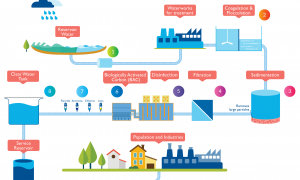🕑 Reading time: 1 minute
What is Canal Fall?
Canal fall is a solid masonry structure which is constructed on the canal if the natural ground slope is steeper than the designed channel bed slope. If the difference in slope is smaller, a single fall can be constructed. If it is of higher then falls are constructed at regular suitable intervals.

Location of Canal Falls
Location of canal fall depends upon the following factors
- Topography of canal
- Economy of excavation or filling
The above two will decide the location of canal fall across canal. By understanding topographic condition we can provide the required type of fall which will give good results. At the same time, the provided falls is economical and more useful. So, economical calculation is also important. Unbalanced earth work on upstream and downstream result the project more uneconomical.
Types of Canal Falls and their Importance
The important types of falls which were used in olden days and those which are being used in modern days are described below:
- Ogee falls
- Rapids
- Stepped falls
- Trapezoidal notch falls
- Well type falls
- Simple vertical drop falls
- Straight glacis falls
- Montague type falls
- English falls or baffle falls
Ogee Canal Falls
Ogee curve is the combination of convex and concave curves. So, Ogee fall consists of both convex and concave curves gradually. This gradual combination helps to provide smooth transition of flow and also reduce the impact. If the canal natural ground surface is suddenly changed to steeper slope, ogee fall is recommended for that canal. Stone pitching is provided in the upstream and downstream of the fall.


Rapid Canal Falls
Rapid fall consists a long sloping glacis. It is constructed if the available natural ground surface is plane and long. For this, a bed of rubble masonry is provided and it is finished with cement mortar of 1:3 ratio. To maintain the slope of bed curtain walls are provided at both upstream and downstream. Rapid falls are high priced constructions.


Stepped Canal Falls
As in the name itself, stepped fall consist vertical steps at gradual intervals. Stepped fall is the modification of rapid fall. It is suitable for the canal which has it upstream at very high level as compared to downstream. These two levels are connected by providing vertical steps or drops as shown in figure.


Trapezoidal Notch Canal Falls
In case of trapezoidal notch falls, a high crested wall is built across the channel and trapezoidal notches are provided in that wall. Trapezoidal falls are very economical and suitable for low discharges. Now a days this type of falls are using widely because of their simplicity and popularity.

Well Type Canal Falls
Well type falls are also called as syphon drop falls. In this case, an inlet well with pipe at its bottom is constructed in upstream. The pipe carries the water to downstream well or reservoir. If the discharge capacity is more than 0.29 cumecs then downstream well is preferred otherwise reservoir is suitable.

Simple Vertical Drop Falls (Sarda Type fall)
Simple vertical drop fall or sarda fall consists, single vertical drop which allows the upstream water to fall with sudden impact on downstream. The downstream acts like cushion for the upstream water and dissipate extra energy. This type of fall is tried in Sarda Canal UP (India) and therefore, it is also called Sarda Fall.

Straight Glacis Canal Falls
This is the modern type of construction, in which a raised crest is constructed across the canal and a gentle straight inclined surface is provided from raised crest to the downstream. The water coming from upstream crosses the raised crest and falls on inclined surface with sufficient energy dissipation.

Montague Type Canal Falls
Montage fall is similar to straight glacis fall but in this case the glacis is not straight. It is provided in parabolic shape to introduce the vertical component of velocity which improves the energy dissipation to more extent.

English or Baffle Canal Falls

In this case, straight glacis fall is extended as baffle platform with baffle wall. This is suitable for any discharge. The baffle wall is constructed near the toe of the straight glacis at required distance in designed height. The main purpose of the baffle wall is to create hydraulic jump from straight glacis to baffle platform.


